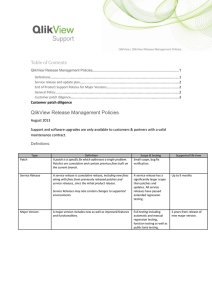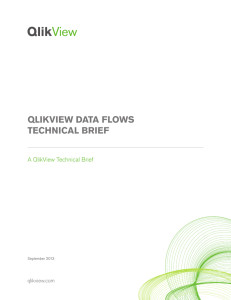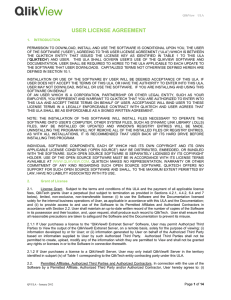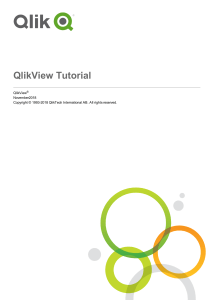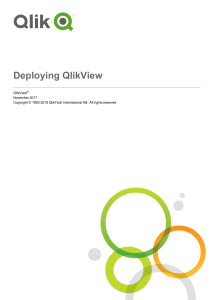QlikView_in_Banking_1.0
advertisement
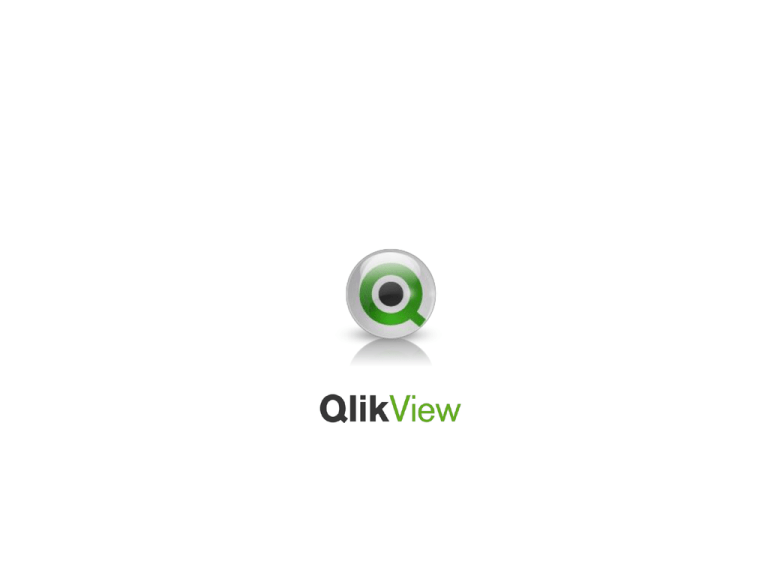
A Fundamental Difference A Fundamental Difference WHERE [Fiscal Year] = 2004 AND ([Fiscal Month] = ‘Apr’ OR [Fiscal Month] = ‘May’ OR [Fiscal Month] = ‘Jun’) AND [Division Name] = ‘Domestic’ AND ([Region Name] = ‘Northeast’ OR [Region Name] = ‘Southern’) AND ([Product Type Desc] = ‘Breakfast Foods’ OR ([Product Type Desc] = ‘Dairy’ OR [Product Type Desc] = ‘Eggs’) Answer questions at the “Speed of Thought” Associative In-Memory Technology In Memory Analysis Feature: Leverages 64-bit/multi-core Hardware Platform Benefit: Large datasets Many users Data queried in memory Fast queries No load on operational systems Aggregates calculated as clicked Freedom in selecting measures/dimensions Infinite drill-down/around Visually Interactive UI Easy-to-use “Sex and Sizzle” Start Small Average implementation time1: Implementation Time for BI Initiative1 17 months in total; 5 months to deploy the first usable analytic application Mean annual expenditure on BI software2: $1.1 million for companies with >1,000 employees Project success rate1: 30% 25% 25% 23% 20% 31% success rate, at best Meeting needs - right data to right person2: 16% 15% 12% 11% 10% Only 36% are confident that reports and dashboards deliver the right data, to the right person, at the right time 7% 5% 5% 0% Less than 2 months 1 2 DM Review & IDC Business Intelligence Survey, October 2006, 2004 (Material on implementation time not available in 2006 survey) InfoWorld & IDC Business Intelligence Survey, October 2007 2–5 months 6 – 11 months 12 – 17 months 18 – 24 months 25 – 48 months 49 months or more A Fundamental Difference Thought Driven Start Small Flexible & Easy 30% 25% 25% 23% 20% 16% 15% 12% 11% 10% 7% 5% 5% 0% Less than 2 months 2–5 months 6 – 11 months 12 – 17 months 18 – 24 months 25 – 48 months 49 months or more Our Mission Simplifying Analysis For Everyone Performance Challenges in Banking Customer Acquisition & Retention Expand Share of Wallet in Customer Portfolio “Address economic slowdown and intense competition by retaining market share and adjusting to new demographics (such as larger senior population and migratory consumers.” “Increased emphasis on revenue generation goals through nimbler product development and innovation, expansion into new geographies, and improved and actionable customer insight.” “Address new opportunities in emerging economies (such as the new mass affluent, small businesses, and the unbanked).” Streamline Back Office Operational Processes Manage Risk Exposure “Adopt lean production and highperformance strategies of manufacturers to streamline customer interaction and transaction processes.” “Appropriately manage risk exposure across multiple fronts with regards to market risk, compliance, security and privacy.” QlikView for Retail and Investment Banking Product Development and IT Executive • Product Portfolio Analysis • Product / Project Management • Product Performance by Market Segment • System Performance Controlling • Infrastructure Planning / Sizing • Balanced Scorecard • Performance Management • Predictive Analysis • What-if Analysis • Activity-Based Management Asset / Wealth Management LOB – FI, Derivatives, Equity • Assets / Cash Distribution • Portfolio Analysis & Performance • Manager Performance • What-if Analysis • Market Data Services • Market Price Monitoring – Current/Historical • Heat Map & Exposure • LOB Portfolio Analysis & Transactions • Performance – Margins, Commissions Finance & HR Customer Management • Financial Consolidation Reporting • P&L Analysis by LOB / Branch • IFRS / GAAP Accounting Compliance • Sustainability Reporting • Workforce and Benefits Analysis • Targets, Fees/Assets, Commissions • Customer Portfolio Analysis (Heat Map) • Customer Segmentation, Value & Profiling • Customer Cross-sell and Up-sell; MCIF • Marketing Campaign Performance Dashboard Risk Management & Compliance • Credit risk • Market risk • Operational risk • Compliance – Basel II, SEPA, KYC, AML, USA Patriot Act, HIPAA Analysis Reporting Payment / Transaction Processing • Clearing, Settlement, and Reconciliation: • Payments (SWIFT, ACH, BACS, EDI) • ATM / Credit / Debit Card Transactions • Mortgages / Loan Processing • Anti-Money Laundering / Fraud Identification Select QlikView Customers in Banking More Than 200 Banks Are Leveraging QlikView (Unbelievably) Fast Implementations Large Investment Bank 4 weeks implemented 3 weeks implemented Large Wealth Management Company 12 weeks implemented 8 weeks implemented Large Retail Banking Company 2 weeks implemented 4 weeks implemented Large Investment Bank 15 days implemented 7 weeks implemented Delivering High Performance for Large Data Volumes Cross Industry 15 – 20 TB of data or 2 billion records analyzed on doctors, patients and diagnoses Banking Large Investment Banking Company Couple terabytes of data analyzed 200 GB of data or 140 million records analyzed on claims data with compression to 500MB Large Wealth Management Company 56 million transactions analyzed with compression of 90% Large Retail Banking Company 4 millions customers analyzed across demographics for marketing campaigns 12 million patients with interaction records analyzed Large Investment Banking Company Large data volumes analyzed on fixed income trades 5.5 million records integrated, cleansed and analyzed 5 million records pulled from multiple data sources 5 million records pulled from multiple data sources 200 million records analyzed Millions of customer records analyzed Large Investment Banking Company Millions of records analyzed 5 million records analyzed Supporting Large Scale End User Deployments Cross Industry 24,600 users at Laredo (USA) Independent School District 11,000+ users at 3M 11,000+ users at Pfizer Banking Large Investment Banking Company 600 users growing to 1,000 by year end 2007 Large Financing Company 500 users Large Investment Banking Company 500 users 11,000+ users at Sanofi-Aventis 200 users at LRP 10,000+ users at AMS (Sweden) 200 users at Nedbank 4,500+ users at Bristol-Myers Squibb Large Investment Banking Company 100 users growing to 500 users in the fall of 2007 About QlikTech Heritage Board • • • • • • • Paul Wahl, former COO Siebel and CEO SAP America • Alex Ott, JVP, former President Siebel North America • Bruce Golden, Accel, former Executive at Sun, Illustra and Informix • Claes Bjork, former CEO Skanska • Måns Hultman, Chairman & CEO QlikTech Founded in 1993 in Sweden R&D located in Lund, Sweden Granted patents on in-memory associative technology Eight major QlikView product releases QlikView 8 released in 2007 Lead investors – Accel Partners and JVP Organization Results • Management Team: – Former executives from SAP, Siebel, Oracle, PA Consulting, Mactive, Intentia • ~300 employees across 15 offices in 6 countries • More than 300 partners • Headquartered in US (Radnor, PA) • Leading provider of next generation BI solutions • Fastest growing BI software company in the world for two years running (2005 – 2006) according to IDC • Profitable, annual revenue growth of ~80% • 6,125 customers in 76 countries • Adding 12.5 new customers every day • 276,000 live users Successful Customers Across Many Industries Industry Recognition & Awards Broad Software Industry Recognition Red Herring 100 Award Winner Named a Winner of Red Herring 100 Spring 2007 Award given to the top 100 private technology companies based in North America driving innovation. Sand Hill Group Innovation Showcase Winner Selected as one of 25 companies in the Innovation Showcase at the Software 2007 conference. Recognized in the Fast Track category for the company’s significant market traction. BI Software Industry Recognition Gartner Group Recognition as ‘Visionary BI Provider’ Predicts predominance of ‘In-Memory’ BI solutions for 70% of Fortune 1000. Recognized as a ‘Visionary’ in Gartner Group’s annual Magic Quadrant (2007). IDC Recognition as ‘Fastest Growing BI Company’ Acknowledged as the fastest growing BI software company in the world for two years in a row (2005 2006) with profitable, annual revenue growth rates of ~80%. Solution & Customer Recognition Morgan Stanley CTO Summit Innovation Award CTO Summit Innovation Award Recognized by Morgan Stanley as a leading technology innovator at its 2007 CTO Summit. Technologies are acknowledged for their impact on the marketplace and within Morgan Stanley. Gartner Group Best Midmarket Solution Software Award Named QlikView as the IT Executives’ choice for ‘Best Midmarket Solution Software’ at Gartner Midsize Enterprise Summit 2007 in Atlanta. FierceHealthIT - Top Healthcare IT Innovator Award Named one of ten top innovators delivering disruptive technologies to the healthcare IT industry in 2007 according to FiereHealthIT. The Computerworld Honors Program Laureate Award Awarded for the Sahlgrenska University Hospital case study for the use of IT to benefit society. Recognized in the Business and Related Services category in 2007. Nominated by Morgan Stanley. QlikView Leads Next Generation BI “70% of Global 1000 organizations will load detailed data into memory as the primary method to optimize BI application performance and flexibility. With in-memory technology, users can freely explore detailed data in an unfettered manner without the limitations of a cube.” 1 Vision: • Performance: “[QlikView’s] technical advantages using an in-memory data model, automated data integration and a graphical analytical environment have attracted customers looking for both ease of use and highly scalable functionality.” 2 Gartner Group Magic Quadrant Business Intelligence Platforms 2007 • Architecture: “Beyond the performance capabilities, QlikTech has some unique architectural and contractual aspects. For example, by simultaneously ‘doing the inner and the outer join,’ QlikView makes it very easy for users to see both the query results and the non-query results. This functionality can be useful when performing analysis of the data, in particular when spotting outliers.” 2 Execution: • Growth: “QlikTech executed very well in 2006, increasing its revenue by 80% and significantly expanding its customer base to over 5,400 organizations.” 2 • References: “Ironically, QlikTech — one of the smaller vendors evaluated in the Magic Quadrant — is able to show the most references, analyzing hundreds of millions of rows of data with good query performance.” 2 1Kurt 2 Kurt Schlegel among others, “BI Applications Benefit From In-Memory Technology Improvements”, published 2 October 2006, pages 2-3 Schlegel among others, “Magic Quadrant for Business Intelligence Platforms, 1Q07”, published 26 January 2007, page 13 ●QlikTech (Jan 2006) Providing An Integrated Approach Traditional BI Stack User Interface, Dashboards, Scorecards, Reports • User Interface OLAP, Query and Reporting tools Data Marts Data Warehouse Lots of tools One tool Multiple vendors One vendor • Chart and Report Engine IT driven End user driven • Analysis Engine Months to change Minutes to change • Data Compression High Cost Low Cost • Integration Integration Layer (ETL) ERP Unstructured Data CRM ERP Unstructured Data CRM Simplifying Analysis for Everyone Everyone Else QlikView New Rules “Fast Implementation” • Fast Implementation… Customers are live in less than 30 days, and most in a week “Easy-to-Use” • Easy to Use… End users require no training and enjoy “qliking” through the application “Powerful” • Powerful… Near instant response time on data volumes as high as a billion records across thousands of users “Flexible” • Flexible… Allows unlimited dimensions and measures and can be modified in seconds “Integrated” • Integrated… Dashboards, analysis and reporting in a single solution and on a single architecture “Low Cost” • Low Cost… Less costly, shorter implementations result in fast return on investment “Risk-Free” • Risk-Free… Fully-functional free trial download, and a seeing-isbelieving experience QlikView Value Proposition: 1/4 the Time, 1/2 the Cost, 2x the Value What Would You Say If… You could deploy a complete Business Analysis system— …typically in just 2-3 weeks? You could build and deploy new applications— …in just days or weeks? You could have unlimited multi-dimensional access to your data— …using point-and-click, easy-to-use applications? You could access a billion records— …in seconds? You didn’t have to build a data warehouse— …at all? What if all of this was actually possible?






